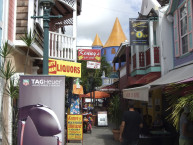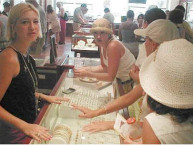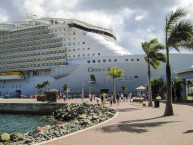Tourmaline
There is a tourmaline color to fit every color in the rainbow. This gemstone group is the largest in the world and can offer you fine jewelry items from the fairly inexpensive, to very expensive. The green variety is the most often seen variety. These stones will range from dark green to almost emerald green of chrome tourmaline.
These stones will range from dark green to almost emerald green of chrome tourmaline.
The red and pink varieties will be called rubelite due to their ability to emulate a fine quality ruby. Most of these stone will be medium to heavily included but the intensity of the red color will outweigh the problem of its clarity.
When shopping for a tourmaline you should look for good color saturation with little or no banding of color. All of the stones should be well cut and proportioned. And since they wear very well, you can choose a tourmaline for any type of wear when considering your jewelry wardrobe.
Many have turned the collecting of Tourmalines into a lifetime hobby. It is the gemstone with the widest color spectrum. In fact hundreds of different hues of tourmaline exist. Every birthstone can be replaced by a tourmaline, since the birthstone is determined not by the mineral itself but its color.
The most important tourmaline deposits in Brazil are in the Cruzeiro Mine, 700 kilometers northwest of Rio De Janeiro, in the State of Minas Gerais. It is owned and operated by Amsterdam Sauer. (a CGI member Jeweler)
The name tourmaline is derived from the Singhalese word “turamali” meaning gemstone. Verdelite is a composed word from the Latin word “verde” =green and the Greek word “lithos”=stone. Dutch sailors which brought tourmalines from Ceylon to Europe in the 17th century, called them “aschntrekkers” because they attracted ashes and could be used to clean pipes.  The reason is the physical property to change its electrical charge when heated, and to become a polarised crystalline magnet which attracts light objects. Today we have fine colors of green to bluish green Tourmaline from Brazil and Africa.
The reason is the physical property to change its electrical charge when heated, and to become a polarised crystalline magnet which attracts light objects. Today we have fine colors of green to bluish green Tourmaline from Brazil and Africa.
Paraiba Tourmaline
The intense “electric” color of the Paraiba tourmaline has captured the interest of fine gem collectors world-wide. Discovery of this gem was credited to Mr Hector Barbosa in 1987 near the small village of San Jose de Batalha in the federal state of Paraiba, hence the name. The original mine where it was discovered was extremely small, no larger than the basic ranch style home, and was exhausted by 1993.
For that reason, gems in good quality are becoming more and more expensive. The surprisingly “new” Tourmaline colors are due to a small amount of copper but also a little bit of gold!  Because of the rarity of this gem and the intense interest especially in the Japanese market, a fine Paraiba Tourmaline can easily reach prices of $20,000 or more per carat.
Because of the rarity of this gem and the intense interest especially in the Japanese market, a fine Paraiba Tourmaline can easily reach prices of $20,000 or more per carat.
The best color is a vivid neon-blue or an emerald green. Even heavy inclusions are accepted, as there are hardly any flawless Paraiba Tourmalines of good color.
Before you shop for Tourmaline: Our best advice before buying fine tourmaline is to visit several large and small jewelry stores before your trip to the Caribbean. Do not tell them you are comparison shopping, but ask to see their selection of fine tourmaline. Ask where it was mined. Notice the richness of the hue, the setting, the size of the gem. Jot down a few notes along with prices per carat etc. Take this knowledge with you on your trip to the Caribbean. An informed consumer usually gets a really fine Jewelry item. When you see the huge variety offered by CGI jewelers, their knowledge of the gems, to knowing which mine they came from, you will be impressed.
While visiting Pierre’s of St Thomas in November, we were shown a fine blue Tourmaline which was a loose stone. The depth of the color was dramatic. It was examined closely under the microscope by our gemologist. I imagined how wonderful and unusual this would present as a ring set in Platinum. Since that time I have made a special effort to find a stone of such quality anywhere. I’m still looking. If you visit St Thomas, stop into Pierre’s and ask to look at the Blue Tourmaline examined by CGI, you’ll see what I mean.




